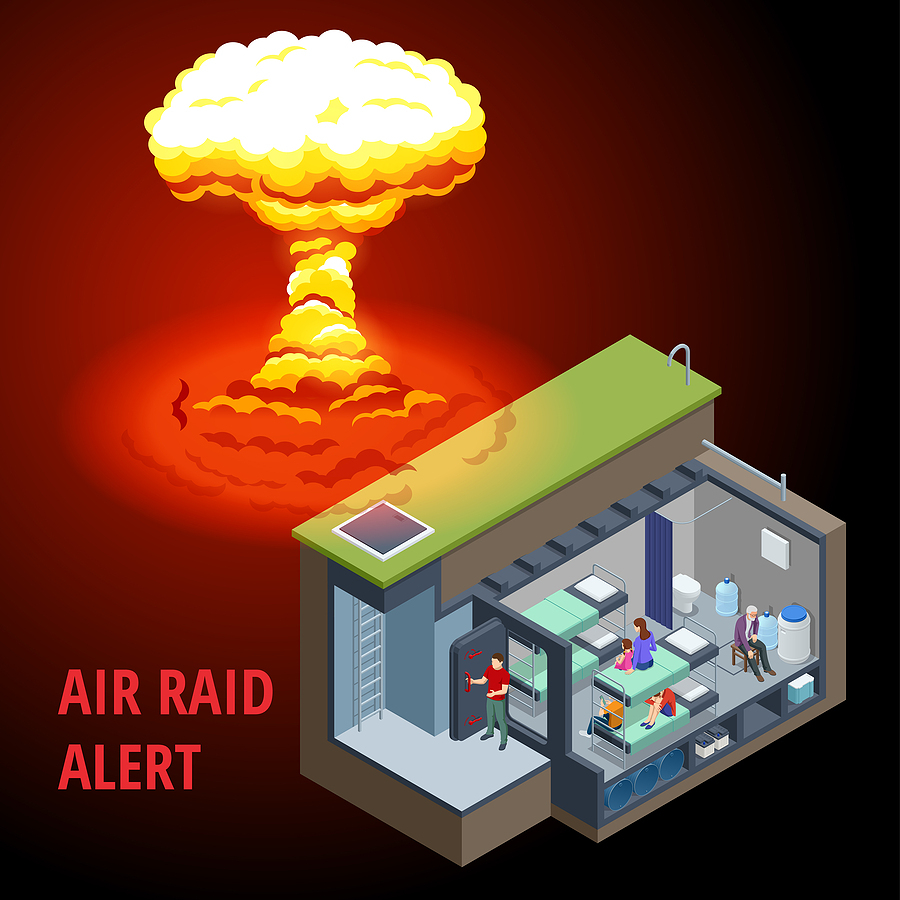Are Today’s Bomb Shelters Able To Withstand Nuclear Weapons?

Nuclear warfare is an existential threat to life on Earth. The nuclear weapons of today are high-yield weapons of mass destruction, capable of wiping the face of the Earth, obliterating life as it is. The way the current state of many nations is moving towards it begets the fundamental question: Is there a way to avoid such a weapon? Could the bomb shelters and underground bunkers of today withstand a nuclear explosion?
Let us find out in this article with Physics Tuition!
Can bomb shelters and underground bunkers withstand a nuclear explosion?
The ability of a bomb shelter or an underground bunker to withstand a nuclear explosion depends on two fundamental parameters – the explosion dynamics of the nuclear bomb and the design of the bunker or shelter. Understanding the two parameters will help us answer the crucial question.
Impact and dynamics of a nuclear explosion
Unlike other forms of incendiaries, nuclear bombs are more deadly and powerful. They generate four different forms of energy, such as radiation (invisible electromagnetic), heat (thermal), light (visible electromagnetic), and blast wave (mechanical).
During a nuclear explosion, a fireball is generated, vaporising everything in its immediate path. It then rises upwards, forming a mushroom cloud. As the blast energy wanes, the matter in the mushroom cloud begins to cool down, forming radioactive dust. The radioactive dust is then carried by the wind, resulting in extensive long-term damage to distant and neighbouring regions.
The blast wave from the initial explosion also causes structural and physical damage to buildings and all sorts of life forms. Other generated forms of energy, such as sound, light, and heat, can cause severe damage, such as spatial disorientation, burns, blindness, and even loss of life.
The most deadly aspect of nuclear explosions is the radiation, comprising of X-rays, gamma, neutrons, as well as alpha and beta particles, all of which irradicate every lifeform, damaging body tissues and even mutating genetics.
A nuclear explosion’s impact is dependent on how high the bomb was dropped from. Based on the height it was released from, the impact can be classified as the following:
1. Sub-surface burst
This type of explosion usually takes place below the land’s surface or underwater. Characterised by their lack of nuclear signatures, such as radioactive dust and mushroom clouds, sub-surface burst creates seismic activity and craters. They also affect underwater and underground resources.
2. Surface burst
This type of explosion takes place near or on the land’s surface. Surface bursts cause significant damage as well as generate widespread radioactive dust towards the explosion’s immediate and surrounding regions.
3. Airburst
This type of explosion usually takes place approximately 30km from the surface of the Earth. Air bursts can be optimised accordingly to maximise certain effects, such as radiation-, physical-, or thermal-induced. Because they take place at such an altitude, radioactive dust is usually dispersed over a wide area by winds, affecting large numbers of regions.
4. High-altitude burst
This type of explosion usually takes place at heights of more than 30km from the surface of the Earth. While high-altitude bursts might not have any significant impact, they can cause a sudden spike in electromagnetic radiation, destroying any sensitive electronics and disrupting communication.
Modern nuclear warheads vs modern bunkers and shelters
Unfortunately, there are no underground bunkers or bomb shelters that can completely reduce the impact and effects of modern nuclear explosions. While they might be able to mitigate high-altitude bursts, nuclear explosions that occur under or close to the surface of the Earth initiate seismic activities, amplifying their impact manifold.
Additionally, unlike the nuclear weapons of yesterday, the ones today can be delivered through missiles which are capable of penetrating the surface of the Earth. For example, the USA has a nuclear warhead capable of yielding 1.2 megatons of energy and can destroy underground bunkers as deep as 305 metres.
Conclusion
Nuclear energy remains of the most misused and misrepresented technologies. Despite how strong it might sound, there are no bunkers or shelters in the world that is 100% immune to the effects of modern nuclear weapons.
Find this topic interesting? A degree in physics opens up a lot of opportunities to specialise in areas such as nuclear science. Here at Physics Tuition, we aim to build up a passion for the subjects in all our students. Whether you are looking for O-level or JC physics tuition, we are eager to help you achieve the results you are looking for. Visit us at http://www.physics.com.sg/ to find out more today!